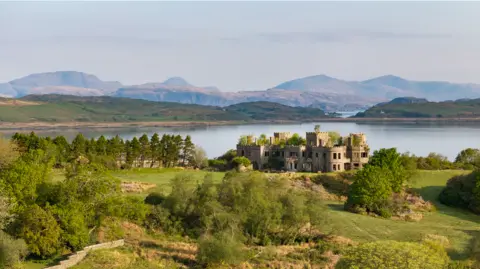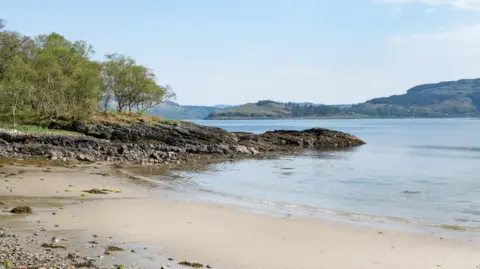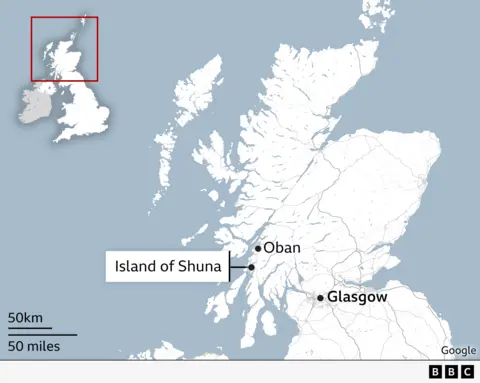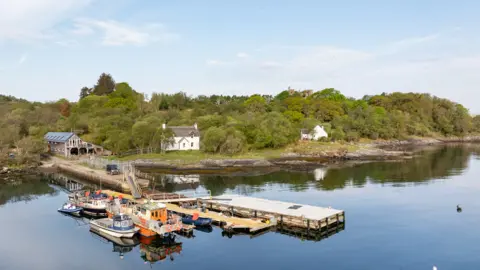Family selling 'idyllic' island with ruined castle after 80 years
 Sotheby's/Knight Frank
Sotheby's/Knight FrankEighty years after a mother walked into a London estate agency and bought a Hebridean island she had never seen, her family is selling their historic home.
Shuna, which includes a now-ruined castle, working farm and a holiday accommodation business, has been home to the Gully family since 1945, but is now on the market for £5.5m.
Jim Gully, who was the second generation of the family brought up on the island, said its white sand beaches and rocky coves gave them an "idyllic" childhood.
The estate agents said the sale of the 1,110-acre island, off the west coast of Scotland, was a "truly rare offering".
It has already attracted a range of inquiries from potential buyers looking for a private retreat, tourism business or rewilding project.
 Jim Gully
Jim GullyThe wildlife haven has belonged to the the Gully family since the Dowager Viscountess Selby - a descendant of the politician Sir William Court Gully who was given the title on retirement as Speaker of the House of Commons - approached an estate agent after the war, asking if they had any islands on their books.
"Everyone was so traumatised by what had gone on in the war that they were looking for a fresh start," her grandson Jim Gully told BBC Scotland News.
"Without ever having seen it she bought the island and moved her family up."
His father Eddie, the fourth child in the family, was brought up on Shuna from the age of three months.
He is now living on the Isle of Seil, which is linked to the mainland by road.
"He's had 80 years of stewarding and looking after Shuna and trying to get all sorts of businesses going and has absolutely loved it the whole of his life," Mr Gully said.
"My brother and I grew up on Shuna. We were home schooled by our grandfather [Donald Wells] on the island.
"It's idyllic for a childhood being taught there, running the farm and the holiday cottages, and we still do that."
 Sotheby's/Knight Frank
Sotheby's/Knight FrankThe Atlantic island's position in the Hebridean archipelago protects it from the ocean swells, but occasionally brings inhabitants the challenge of navigating the Corryvreckan whirlpools.
"Quite often over the years we've had to go Corryvreckan with a boat laden with sheep, so that's led to some exciting journeys," Mr Gully said.
Over the past 12 years the island has been managed by Rob and Kathryn James, who live full-time on Shuna, but their plan to move into another role prompted the family to consider selling up.

Viewings start later this week, but in the meantime regular visitors are securing their stays for the rest of the year.
"It's been a huge part for all of our lives and definitely sad that all of that is coming to an end, but tinged with relief for my father that it's going to be slightly easier not having to manage all of that and getting over to the island three or four times a week," Mr Gully said.
The castle was built with "no expense spared" by New Zealand-born adventurer George Alexander MacLean Buckley in 1911, just three years after he joined an Antarctic voyage on Nimrod with Ernest Shackleton.
The castle blueprints, and the architect who designed them, are believed to have been on the Titanic's fateful voyage.
 Sotheby's/Knight Frank
Sotheby's/Knight Frank"He was about to export the plans to America and build a lot more of them," Mr Gully said.
"The plans for it went down with the Titanic and stopped lots of flat-roofed castles being built in America."
Shuna castle fell to ruins in the 1980s when its upkeep became too costly.
"I lived in there for my first 10 years and I can look in the old bedroom window and see the room where we were taught by my grandparents - it's all very fresh in the memory," Mr Gully recalled.
He said the children were taught "maths, English and lateral thinking" in the mornings, then "booted out" to explore the island.
By then the family was using only about a quarter of the castle as the rest of it was beginning to fall down.
"When we were moving the furniture around the room to find the bits where it wouldn't fall through the floor, you knew your days were numbered," Mr Gully said.
He added: "It still looks very impressive even though there are trees growing out of the windows."
 Jim Gully
Jim GullyThere have been human settlements on Shuna, one of the Slate Islands, for at least 4,500 years, evidenced by Stone and Iron Age burial mounds and ruined farms and houses.
Limekilns from the 18th and 19th Centuries remain dotted around the island and it is estimated that there was a population of about 80 people between 1750 and 1850.
As well as the Gully's herd of 220 Beulah sheep, the island is home to red and fallow deer, numerous bird species and otters.
It offers regular sightings of passing seals, porpoises and dolphins.
Birds of prey, including golden and sea eagles, can also be spotted in the area.
Visitors to the island's six holiday homes, which can house up to 52 people and are powered by sustainable energy supplies, are normally taken on a 20-minute boat trip from the pier at Arduaine on the mainland, but the island also has a helipad.
The island is being marketed by UK Sotheby's International Realty and Knight Frank.
The estate agents suggested the property, one of two islands named Shuna near Oban, was "perfectly suited" to multi-generational living, a boutique hospitality venture or a "wellness destination".
